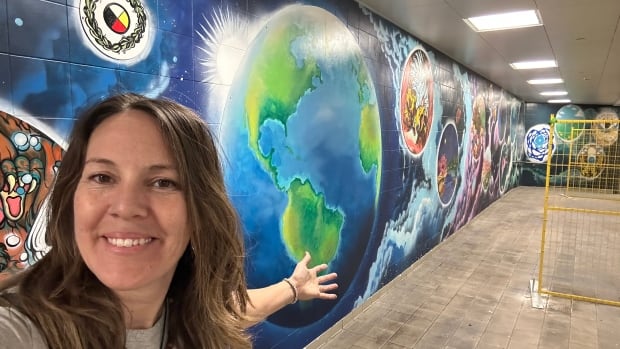This is a First Person column by Carla Rae Taylor, who lives Edmonton. For more information about CBC’s First Person stories, please see the FAQ.
“Thank you so much,” I heard her say through the temporary cage that surrounded me to keep me safe while I painted.
The mural I was painting was in the heart of Edmonton in an underground pedway between train stations. There are people of many walks of life that frequent this hallway, including those that seek refuge from extreme poverty and find themselves homeless.
“Thank you for the art,” she said. The woman, who looked Indigenous, no more than 20 and was likely living in the streets, was holding onto a baby stroller. There was no child in it; only a mess of her possessions. Indigenous woman to Indigenous woman, my heart bled for her situation.
As though the young woman was an angel of serendipity, she arrived just as I was grappling with whether or not I should be expending all this creative and physical energy painting murals in places that are likely to be defaced with mindless scrawls or other creative markings.
My heart swelled with a mix of joy and sadness. Joy because her praise of the artwork reaffirmed that the work I was doing was valued by those that inhabit this space, and sadness that her and her comrades who were slumped up against the wall had few other places they can be indoors.
Having worked in the inner city of Edmonton for many years teaching art to youth living in the streets, I knew stories like hers well. I had seen her situation all too often in so many of our Indigenous brothers and sisters whose lives and impoverished situations are a direct result of the genocide of Indigenous populations in Canada’s recent history. And I was reminded why I had started painting this mural in the first place.
How it began
I started partnering with the John Humphrey Centre for Peace and Human Rights and Edmonton Transit Services as the lead artist on a number of large-scale murals in public transit stations in 2017. The murals tell the stories of Edmonton’s diverse cultural communities and how they came to be a part of our city.
For this project in the pedway, the group painting process began with the burning of sacred Indigenous medicines, the sharing of stories and traditional teachings from local Elder Jo-Ann Saddleback and knowledge keeper Lana Whiskeyjack. I love to start my murals in this way. The stories shared always deepen my connection to the land and place, and provide ample tinder for my creative fire.
There is also something very powerful about sharing Indigenous wisdom with a group of culturally diverse artists that call this land home. One of the participants couldn’t hold back her emotions as she shares how the elder reminds her of her late grandmother. With a warm embrace, the elder explains how it is the deepest honour to be called grandmother by people of other nations.

The game plan
The first time I walked into the pedway I envisioned a glowing Mother Earth in the centre of the wall as a reminder of sorts to the people living in the underground to reconnect with nature and to live in healthy relationship with our home, the Earth. The session with the elder and knowledge keeper reaffirmed that my fellow artists and I should create an art piece in honour of our planet. As the lead artist, my plan was to fill the massive 127-feet long wall with an astral scene, and each artist woukd paint their interpretation of a relationship to the Mother Earth on top of the astral scene.
When everyone finished with their creations, I was in awe of the colourful images and deeply thoughtful paintings. We sat in a circle and listened as each artist described their concept to the group. One man explained how sitting in nature and taking time to breathe while watching the clouds float past calmed his mind and soothed his troubles. I couldn’t help but shed a tear as a pregnant mama artist described her experience of oneness with all of life when connecting with nature. The paintings communicate a sense of connection, community, purpose and meaning.
Messages of inclusion started to fill the once-bleak space. It made me proud to be a part of a community that celebrates diversity through the arts and supports projects that create bonds of friendship and partnership among people of incredibly different cultural and social backgrounds.

Although I knew while my artwork, once finished, would likely become a fresh target for mindless scrawl, I still believe that offering messages of hope through the artwork will perhaps touch people living in dire conditions and also inspire all walks of life to connect with nature and celebrate the beautiful tapestry of multiculturalism that we are all a part of.
Do you have a compelling personal story that can bring understanding or help others? We want to hear from you. Here’s more info on how to pitch to us.


